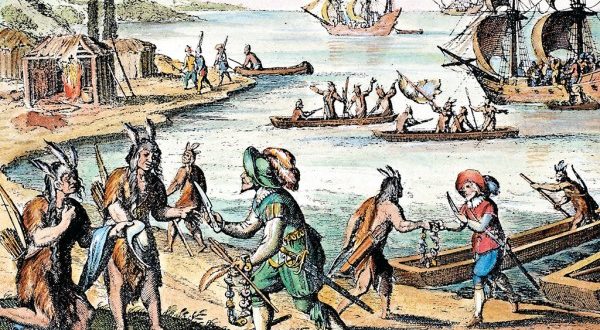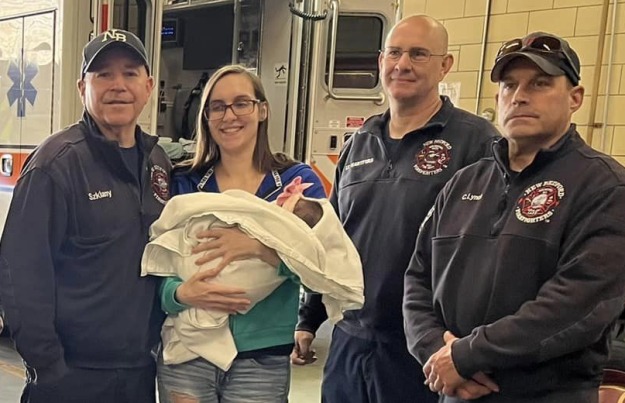Preamble or Pre”ramble”?
Batholomew Gosnold isn’t exactly the first name that comes to mind when people discuss Europeans that came to the New World, but with Gosnold we may not have the America we know today.
While it’s all the rage and quite in vogue to hate on any European that came to the Old World because to these haters they symbolize genocide, consumerism, and the “…progress of the American hegemony through the power of the military-industrial complex headed by the Bilderbergers, Illuminati, and Reptilian and Gray Overlords of this flat-earth” that is only one part of reality. Those aren’t my words by the way- those are actual words said by someone being very serious and you’ll find some variant of that to be pretty common.
The truth is multi-faceted as illustrated so powerfully in the parable of the blind men and an elephant. Each one grasps a part of the elephant and they all argue that an elephant is exactly how they feel it to be and everyone else is wrong…all the while missing what an elephant really is.
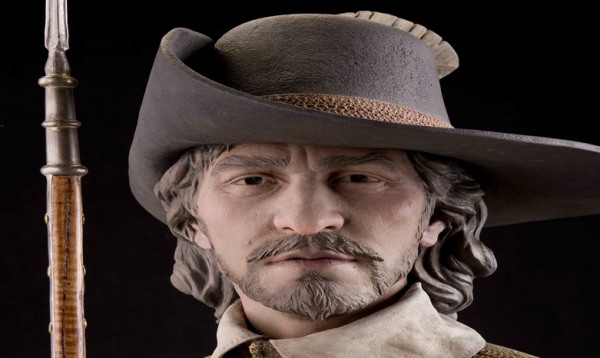
While the coming of Europeans to the New World did lead to injustices, genocide, crimes against humanity, and unspeakable horrors, it also led to many inventions, modern medical cures, a nation founded in liberties, freedoms, and unalienable rights and many countless other positives. Millions see it one way and millions see it the other way, yet both think they are right and if the internet age could be summed up in one sentence, it would be “I’m here to show you that ‘I’m right and you are wrong.'”
In fact, this simple slogan is at the source of pretty much every single conflict alive today, whether as mundane as a Tweet exchange or as monumental as the conflict between nations. If you feel that mankind is essentially evil and Europeans especially so, you won’t be ever convinced that they are also capable of good things. I’d suggest that you dump this article and find a pursuit of misery and unhappiness elsewhere.
If you feel differently in that good did come out of that evil, or that the truth is always more complex then read on.
Landed in Dartmouth, Fairhaven or New Bedford?
Bartholomew Gosnold for those who aren’t familiar with the name or his role in history is within pop culture known as “The guy who came to Olde Dartmouth a long time ago looking for cod. One of the first Europeans to come here, if not the first.” In fact, he is the first man known to lead an expedition to Cape Cod.
Yes, that means before the Leideners came in 1620. Ol’ Bart arrived almost two decades before the famous Pilgrims arrived in 1602 at “Smoking Rocks,” a scene captured so well by the talented Willam Allen Wall’s painting.
Where exactly is this Smoking Rocks? There is some dispute about that. Orthodox accounts say that it was “…on the west side of the Acushnet River, somewhere around the South Terminal, northwest of Palmer’s Island.” and yet others suggest Sconticut Neck or West Island in Fairhaven. It’s immaterial where specifically he landed, just that he did arrive here.
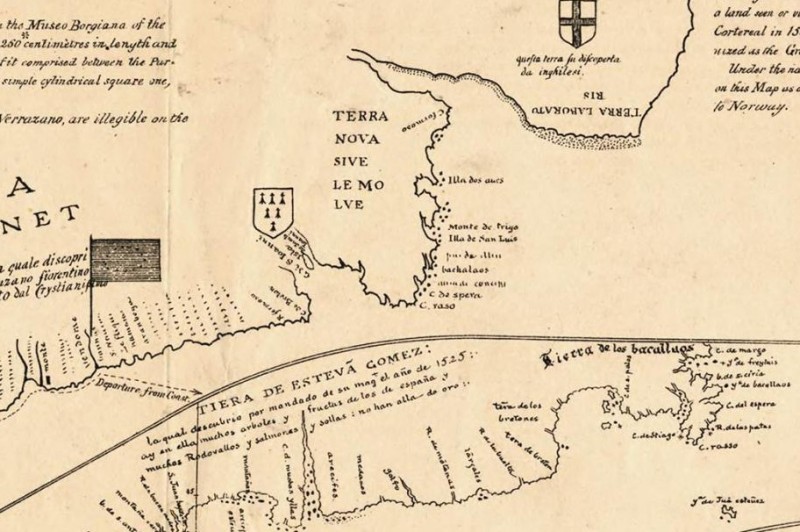
The Verrazzanno Map of 1529 that inspired explorers like Bartholomew Gosnold with placenames like “Land Of Cod.”
So why should we care? Well, besides the fact that it was his arrival, description of what he saw – the rich, natural resources, the helpful Wampanoags, and then letting everyone in the Old World know about it, it is probably that it is his very account that inspired the Leideners to consider Cape Cod in the first place. Perhaps they would have tried elsewhere, had a different experience, died out and disappeared like the Roanoke Colony that arrived in Virginia in 1585, and America may never have existed.
That means you – the very person reading this – would not exist. Or if you did exist it would be in the country of your ethnic origins. Considering that people fled the Old World because of its crime, disease, lack of freedoms, serfdom, and too many hardships to name, it is likely that you would not have existed at all. So, no Gosnold, no description of huge shoals of cod as a source of sustenance, no description of the New Bedford/Fairhaven/Olde Dartmouth region, no Leideners deciding to leave the Netherlands and come here.
Regardless, Gosnold’s visit here was a very short one and his mention of the region and its inhabitants was not much more than a passing one. Why did Gosnold even come here in the first place? What did he do for a living and what was his motivation or inspiration? Where did he go after leaving here?
Origins; Embarkation of the Pilgrims
Bartholomew Gosnold was an Englishman born (1571) and raised in Suffolk, a county in the central southeast of England. Being 150 miles away as the crow flies from Southhampton, Hampshire where both the Speedwell and Mayflower first embarked from you can see how much of a role Gosnold’s account played in the decision by the Leideners to come to Cape Cod. As history tells us both ships were cruising along when the Speedwell took on water and both turned back to England.
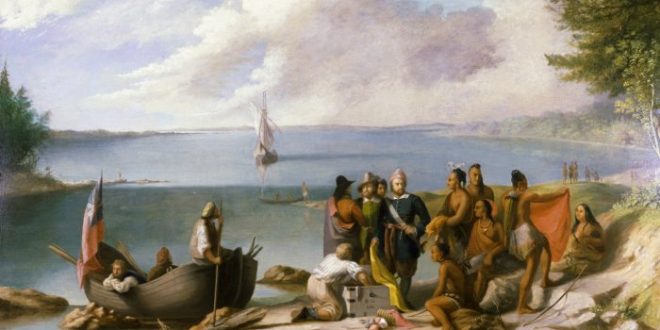
Where did they return to? A place you may have heard of: Dartmouth in the county of Devon. The Speedwell apparently possessing a hull akin to a colander it sprung leaks within an hour after leaving Dartmouth and had to “pull over” at another town you may have heard of: Plymouth, also in County Devon.
The point here is that England, a country known through history for their naval capabilities, shipbuilding, and colonization, had coasts bedecked with coastal towns that were hubs and centers for shipbuilding, trade, as well as launching points for exploration and Gosnold was born right amid one of those hubs with a day’s travel to the Leideners launching point and undoubtedly his accounts spread like wildfire all over the region. Within 15 years of Gosnold’s account, the Pilgrims launched from the same region.
Gosnold the man was an explorer and privateer, but he started out as a lawyer. He was one of the founding members of the Virginia Company of London and Jamestown colony, paving the way for the colonialization of all Virginia. What is mostly unknown is that coincidentally Gosnold spent considerable time exploring the Azores before he ever came to Cape Cod or Virginia.
When it comes to his specific decision to come to Cape Cod he embarked from Falmouth, England aboard a bark built in Dartmouth, Devon called The Concord and with the intentions of founding an English colony and call it “New England.” At that point in history, all of North America claimed by England – the entire coastal region from South Carolina to Maine, plus the island of Bermuda – was called Virginia and this was a way to start laying claim to what was outside those boundaries.
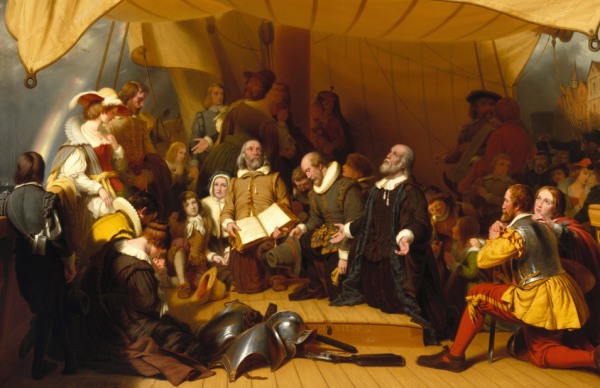
Embarkation of the Pilgrims by Robert Walter Weir.
The inspiration for his exploration was guided by the famous Verrazzanno Map made in 1529 which mentions regions, landmarks and places like New France, Terra Laborato (New Labrador), and Tierra los Bacalluos or Codland for you landlubbers. In other words, this land of cod was what would become Massachusetts.
So set sail from England he did, beelining it for the familiar Azores, then setting his sights for Cape Elizabeth, Maine to which he arrived at on May 14, 1602 where he is said to have met some local Amerindians. Not pleased with Cape Elizabeth, he continued on and the next day arrived in Provincetown Harbor and seeing the sheer abundance of cod, dubbed the area Cape Cod.
He did not, however, make landfall but continued on using the coastline to guide The Concord until he came to what was known as “No Man’s Land.” This was called so not because it was barren of resources, but there were no native settlements or presence. Considering it absent of locals, he decided to name it Martha’s Vineyard after his beloved daughter who passed away a few years earlier.
The “vineyard” part refers to wild grapes he spotted there, just as Leif Erickson mentioned during his exploration six centuries earlier, which he called Vinland. Erickson came upon so many of these wild grapes that he filled his hull with them. Perhaps Gosnold being a fellow explorer and captain decided to pay homage to Leif and his daughter with the name.
Either way, it was at Cuttyhunk Island that he established a small post, though oddly enough the town named after him was at Pasque Island, two islands away. After an assessment of provisions and the capability to tap into local resources, Gosnold realized that he and his crew did not have enough to survive winter and decided to head back home. After returning he spent the next 5 years networking, planning, and organizing until he obtained an exclusive charter from King James I to settle Virginia.
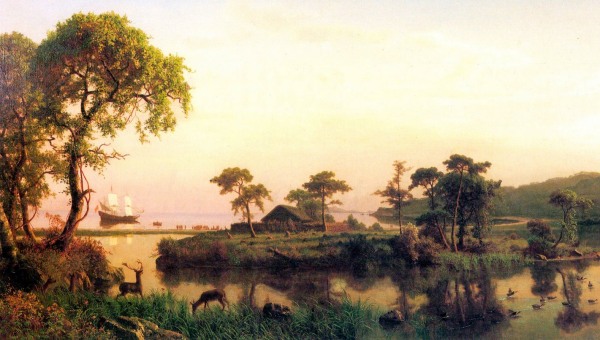
Albert Bierstadt’s “Gosnold at Cuttyhunk.
Apparently, he didn’t see much promise in New England in general and Massachusetts specifically. Perhaps, he felt that the cod and whaling were resources available all along the coast of the New World and with a lack of connections with the local Amerindian tribes, and the harsh climate during winter, he decided New England wasn’t ideal.
In 1607, he made another go to the New World, helping set up the first English colony, Jamestown with fellow Captain, the famous John Smith, among others. The infamous history of Roanoke Colony likely fresh in everyone’s mind, Gosnold likely felt that somewhere more inland might be prudent and practical and promote the idea of Jamestown. This concern of his was validated after the colony’s newly appointed governor, Matthew Scrivener and his brother Anthony Gosnold both drowned while crossing from the mainland to reach Hog Island where some had chosen as the site for a settlement.
Regardless, as history bears out, exploration in the New World was fraught with danger, ruin, and disaster. Captain Gosnold would die at his settlement 4 months later at the age of 36, on August 22, 1607, during a malaria outbreak and the vast majority of the colonists would follow suit within 2 years time. His grave was discovered in 2003 at the site of the original Jamestown settlement, in the western corner of the James Fort.
Gosnold is mostly ignored by historians as he was either overshadowed by the larger than life Captain John Smith or just didn’t have enough “explosions, sex scenes and controversy” that mainstream Americans prefer as part of stories. Ironically, he might have been even more ignored or even forgotten altogether if it wasn’t for the glowing way with which Captian Smith always mentioned Gosnold, even attributing him as the “prime mover” behind the founding of Jamestown.
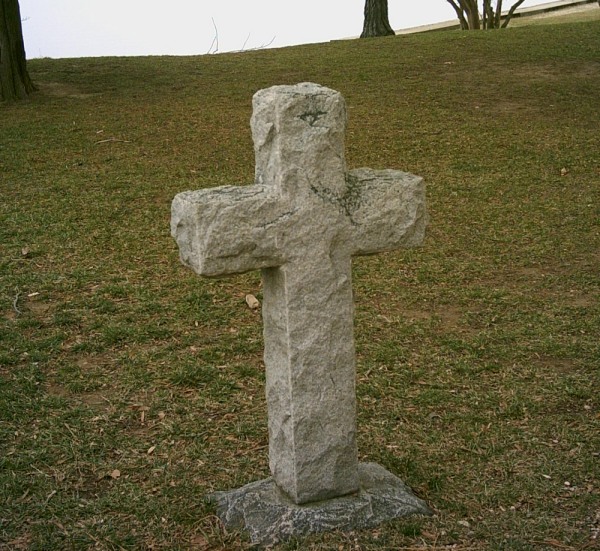
Gravemarker of Captain Gosnold at Jamestown.
By all accounts, Gosnold took good care of his crew, treated the first peoples he encountered with common courtesy and kindness and was an overall decent fellow. Assuming you aren’t one of those who considers spreading the word about the New World so that criminals would follow as a proper crime, his only real crime was being somewhat normal and average.
Perhaps, if he was genocidal, murderous, a rapist or a pedophile, he would have gotten more mention. America loves to love, but it also loves to hate and they sure have a deep love affair with their villains. Gosnold’s crime was that he didn’t commit any, so he has been tossed by the wayside.
Though, funnily enough, he has his own Twitter page where he drops puns, nerd humor, and utilizes modern jargon where he regularly “EVISCERATES” and “DESTROYS” in “BRUTAL” fashion to use the clickbait headlines so popular today. You’ll come across gems like “Finna throw some fists!”, “Getting kinda hungry. Boarding the next ship out.”, “Turtle for breakfast again.”, “Halfway there and realized I forgot my bible??.” and “Getting bored of my crew.. ugh.”
Whether your view of Bartholomew Gosnold is one that portrays him as a cog in the wheel of genocidal machinations or that of a businessman and explorer seeking out a better way of life for himself and others, we wouldn’t have the America we have today. That means, no Gosnold, no Pilgrims, no America, no New Bedford, no you.
And you’re kind of, like, important.
 New Bedford Guide Your Guide to New Bedford and South Coast, MA
New Bedford Guide Your Guide to New Bedford and South Coast, MA

